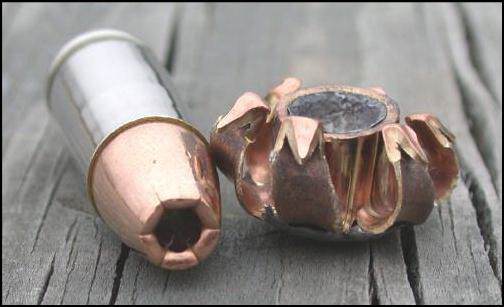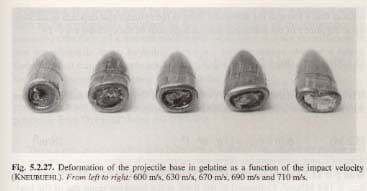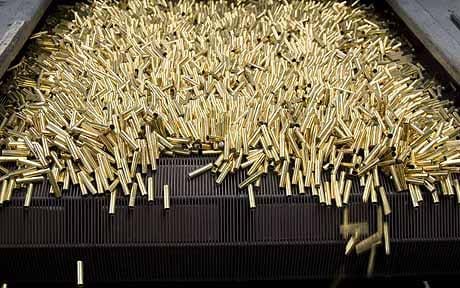There’s an article today on Philly.com about some activists who want to put barcodes on bullets. At first glance it sounds like a great idea — bullets could be tracked back to the person who bought them if they were used in a crime, and we could solve more murders. This sounds a bit familiar to another scheme we discussed, microstamping. And then you remember how bullets work and what this effort would take and the idea loses a little bit of its luster. And by “a little bit” I mean every last shred.
The first question to ask is “what is a barcode?” Wikipedia to the rescue:
A barcode is an optical machine-readable representation of data, which shows data about the object to which it attaches. Originally, barcodes represented data by varying the widths and spacings of parallel lines, and may be referred to as linear or 1 dimensional (1D). Later they evolved into rectangles, dots, hexagons and other geometric patterns in 2 dimensions (2D). Although 2D systems use a variety of symbols, they are generally referred to as barcodes as well. Barcodes originally were scanned by special optical scanners called barcode readers; later, scanners and interpretive software became available on devices including desktop printers and smartphones.
Okay, so a barcode is something that is machine readable, translates to a number or string of characters, and looks similar to this:
 Even using the 2D “QR” style barcodes it comes down to black and white marks and the spaces between them being significant. Distort the proportions and the barcode can become unreadable.
Even using the 2D “QR” style barcodes it comes down to black and white marks and the spaces between them being significant. Distort the proportions and the barcode can become unreadable.
So now we know what a barcode is and how it’s used. The next question becomes how would you put it on a bullet? Microstamping cases is already a technology that’s been created, but bullets (which were specifically indicated in the article) have never been done before.
The easiest and most cost effective way of putting a barcode on a bullet is right on the top of the projectile. Since each box of shells would need its own unique barcode standing all the rounds up and doing them in one go would save time and not drastically increase manufacturing costs. There is, however, a problem with that option.
 Just a small problem. Even with full metal jacket ammunition the bullets will deform as soon as they hit something, obliterating the barcode.
Just a small problem. Even with full metal jacket ammunition the bullets will deform as soon as they hit something, obliterating the barcode.
Plan B would probably be to slap the barcode on the side of the bullet, either in one section or as circumferential rings. The same types of problems arise with this situation, as the distance between the rings will change and the barcode will become unreadable. Not to mention the effect the rifling in the barrel will have on the metal jacket. In short, it’s guaranteed to be erased before the bullet has left the barrel.

That leaves only one place to put a barcode — the base of the bullet. Which would be great except for those pesky superheated gases and intense pressures. Anything stamped on the bottom of a bullet is likely to be extremely deformed and unreadable by the time it gets out of the barrel, and anything that makes it that far has a great chance of being completely obliterated upon impact.
Another reason that base stamping wouldn’t be effective is that it would simply be extremely cost prohibitive. With the tip or the side, the barcode can be applied either by a stamp or by laser etching after the rounds are in the tray and ready for packaging. With base stamping, from the second the bullet is formed by the machinery it needs to be tracked and the factory must ensure that only the 50 rounds with the right barcode on the bases make it into the 50 round packs.
In most factories the ammunition is treated like any other bulk good being produced — another one of countless identical units. Bullets are stored in large hoppers and allowed to mix with other similarly finished rounds before packaging. Implementing this system would mean redesigning factories to accommodate the new requirements, and should any of the rounds in a set fail inspection the entire set must be destroyed or else risk contaminating a box with two barcodes.
With the expense required to reconfigure the factory it would probably make more financial sense for the companies to start manufacturing for export only or simply not selling to shops in that state rather than produce the expensive ammunition.
Like I said before, if there were a 100% foolproof way to have the identity of a shooter revealed when they fire a gun illegally I’d be the first person to support it. But with this effort, the probability of an intact bullet being found and successfully identified are so minuscule and the expense for the system to be implemented so astronomical that it doesn’t make sense. And that’s not even starting on jacketless bullets or unregistered or stolen ammunition being used.
In short, it sucks. Find something better and I’ll get behind it.






How about a barcode on criminals, smack in the middle of the forehead. Scan for criminal record.
I have a bunch of bullet molds in the garage, they should appreciate nicely once this rule goes into effect.
Better yet… how about a big, gold, six-pointed star that reads ‘Jude’?
That would work rather well, as history has shown us.
Just another back door effort to make firearms ownership prohibitive. This must be the real goal since firearms registration and ballistics finger-printing have never been successful in criminal investigations.
To think that criminals would somehow not use a straw buyer for ammunition, or steal it, or destroy markings on it, or manufacture it themselves is sheer stupidity.
I agree about doing something with the criminals. It’s not like they are so sweet and nice and suddenly start shooting people. Usually they have a string of lesser charges culminating in rape, armed robbery, home invasion or even murder. How about we actually prosecute them aggressively early in their career? Stop with the minimum sentences and the plea bargaining away of multiple crimes to make things easy. Since only a small percentage of the population is the issue here, focus on them! Not on me and the millions of other law-abiding citizens.
“…firearms registration and ballistics finger-printing have never been successful in criminal investigations.”
Hey, wait a minute, they do that all the time on the TV! Seriously, is ballistics finger-printing really useless? I’m not contradicting you, I just don’t know.
It’s pretty close to useless.
I studied forensic science for a bit back in school, getting an exact match is difficult under the best of circumstances and downright impossible most of the time. That’s why I always liked fingerprint analysis better — so much more black and white.
Well kiss my grits, another myth perpetrated my our friends in Hollywood. Imagine that.
Any word on that “Physics of Gun Recoil” article?
Somewhere behind the “Competition Shooting 101: IDPA” article but before the “Plastic Magazine Deathmatch” article.
I seriously need to start taking days off from my day job to get this all done…
Looking forward to it, Thanks.
California tried out the microstamping idea with a few hundred pistols that were bought by the Calif Highway Patrol. They collected the fired cases from the CHP firing range, then tried to use the microstamping marks to tie a specific case to a specific gun. Keep in mind that these were guns with known serial numbers, where the fired case “evidence” had not been contaminated by someone dumping a bunch of empties at the scene.
Their successful match rate was under 50%. Try getting a conviction in a court with that kind of “evidence”.
A better, and equally useful suggestion for anti-gun legislators:
Pass a law that requires all criminals to leave their name, address and phone number at the scene of their crimes. The gummint will provided subsidized “business cards” for each criminal, or even potential criminal. They will be passed out to the kids in every class in schools, along with their free breakfast/lunch/dinner/weekend food backpack.
What’s that? It wouldn’t work? So what – it will make the legislators FEEEL as if they are doing something valuable! And hey, if we can save just one child it will be worth it.
Or we could pass a law making murder, armed robbery, and assault with a deadly weapon illegal! Oh wait – we already tried that, didn’t we?
Bottom line – all of this techno-tracking crud is simply a way to make guns and ammo too expensive for the average citizen. What the President refers to as “gun control under the radar”.
“Their successful match rate was under 50%. Try getting a conviction in a court with that kind of “evidence”.”
— America is ‘changing’. That might be a step they take in the future. The Obama Administration via the US Dept of Ed just pushed a new demand onto college campuses. The intent is to lower the burden of proof, using some college committee, to 51% for accusations of sexual harassment and rape. Basically it is a he said she said situation. No real evidence is needed; only the feelings of the committee to act if there is someone they believe a victim. The USG wants to skip the police investigating who kept finding far too many cases of false accusations. Students (males) found guilty will be kicked off campus and their transcripts marked for life why they were kicked off. If you know anyone who has a son in college he needs to be really careful not to piss off the wrong coed.
Hmm… I really don’t have an original solution to this but…
lower taxes / less regulation = more jobs = less poverty = less crime.
Also, by keeping all the illegal drugs illegal, we are not only wasting money, but we are essentially keeping crime rates high. I know all of this makes too much sense, hence it will never change.
activists … want to put barcodes on bullets
Have they considered… RFID chips! ;->
More futuristic: imbed coded magnetic material in the bullet. When fired the high speed movement thought the Earth’s magnetic field will generate a radio signal that can be monitored by spy satellites.
Can we put custom barcodes on the shells, ’cause that’d be cool. I’d love to print up a barcode the reads “If you can read this, you’ve got the wrong guy.” on my reloaded brass.
If barcodes ring up the wrong price for my groceries, I can only imagine what barcoded bullets would do. Here’s a note for all the pointy-headed geniuses out there: work on stopping crime by stopping criminals, instead of waiting for them to kill people so you can run their barcodes. Geez, what a bunch of morons.
+1
How about a crystal micro-chip embedded in everyone’s hand that when fired from a high-tech gun with a coder and licensed to that person will embed the bullet with a special message. That way the Courts can prove which gun the bullet came from and even come with the proof of who squeezed the trigger. The hand chip and gun should not fire unless the legal owner is pulling the trigger. Also, all guns must come with a chip that can be traced by satellite when stolen. The gun should have a 150 decibel alarm that actives when stolen to irritate the thief. If the thief still finds a way to still fire the gun an electric charge should zap the thief and stun that person sending him or her into cardiac arrest.
You are also forgetting that each batch would require it’s own unique barcode. Multiply that by the number of 20, 25, 50 and 100 count boxes, just from one manufacturer and the numbers become too great to be generated into barcode form. Then, of course, there has to be a registration system. It currently is not mathematically possible.
sorry to go OT but If you have the time it would be very nice to see a more revealing review of this new holster system:
http://www.youtube.com/watch?v=h8r6CY5UZyw&feature=player_embedded#!
Someday someone is going to shoot their boobie pulling a handgun out from that new holster.
Without a comprehensive system of ammunition serialization *and* purchase registration (Big Brother, eat your heart out) these jackass schemes would have no chance of having any impact on the unlawful uses of firearms.
They would also be defeated simply by the astronomical number of unserialized cartridges (and components) already in circulation. How many brass cases, primers, bullets, and loaded rounds are already in the private hands of Americans? Lots. Carl Sagan numbers. Bigger than Carl Sagan numbers. Maybe hundreds of billions of rounds?
2.2 billion (yep, with a ‘B’) rounds of .22 rimfire are produced each year, just in the United States. Other countries produce a few billion more. And that doesn’t count the hundreds of millions of rounds of military small-arms ammunition we make each year.
Bullet serial numbers? Not gonna happen.
They could implant a high-g, high-temperature, highly shock resistant, field programmable RFID chip into the base of each bullet, where it is most likely to survive firing, flight and impact. When the buyer goes up to the counter to purchase the ammunition, the clerk simply programs the all of the chips in the lot of ammunition being purchased, with all of the purchaser’s personal data; name, address, phone, email, employer, most recent resume, SSN, vehicle info, bank account/credit card numbers, blood relatives, blood type, sequenced genome, and holographic image of the purchaser. It’s so simple, I really can’t see the problem here. We’ll all be much safer and we’ll be able to catch all of the bad guys. Win/Win!!
@Charles
I’m human, so my memory could be imperfect. It is my recollection that where (was it in Massachusetts?) they have used a pre-sale ballistic finger-printing of a firearm (i.e. shot a round or two through to record the marks on a bullet) and database storage of this information it is a failure (I heard that it is usually not consulted). Subsequent use of this database with later attempts to match a shredded bullet with a specific firearm has not been used in a court case, let alone a conviction, is my (hopefully accurate) understanding.
Sorry for my lack of clarity since they can dig a bullet out of a wall to confirm the caliber and possibly suggestive bullet scratches to match to a firearm. That’s at least reasonable. So, you are correct and my statement was too extreme. Sorry.
What I’m railing against is the intrusiveness and likely lack of effectiveness of a “database” set up before the sale of a firearm to record what a bullet might look like after fired from a specific gun. I suspect that if you fire 20 rounds through it the wear patterns would have changed. So, I believe it is a just a ruse for gun registration, that is all.
I think the MD and NY are the only two states that require so-called ballistic fingerprinting for firearms sold in those states.
Thanks for the clarification.
Continuing my apology for my poorly supported rant…I think I should have said that firearms registration and ballistics finger-printing are of dubious utility for reducing violent crime. I think I can stand behind that statement. It has enough wiggle-room that a lawyer could drive a truck through it.
Hanging my head in shame because I sound about as credible as one of the gun control freaks without citations for their “evidence”.
Come on, why would we expect gun control advocates and legislators to understand the practicalities of firearm operation?
“With the expense required to reconfigure the factory it would probably make more financial sense for the companies to start manufacturing for export only or simply not selling to shops in that state rather than produce the expensive ammunition.”
Ding ding ding ding ding! You’ve figured it out. As Noam Chomsky says, “Intent can be inferred from predictable outcome.”
Comments are closed.